Fatigue Reliability Assessment of RC Beams in Heavy-Haul Railways Based on Point Estimate Method
Abstract
:1. Introduction
2. The Fatigue Performance Function for RC Beams in Heavy-Haul Railways
3. Point Estimate Method for Structural Reliability Evaluation
3.1. Statistical Moment Estimation of the Performance Function
3.2. The Failure Probability of Performance Function
4. Engineering Application
4.1. Project Overview
4.2. Random Variables and Their Probability Distributions
5. Results and Discussion
5.1. Fatigue Reliability Evaluation
5.2. Influence of Annual Traffic Volume and Axle Weight of Trains
6. Conclusions
- The fatigue reliability evaluation method for heavy-haul railway RC beams based on the point estimate method can efficiently and accurately evaluate the fatigue reliability of heavy-haul railway RC beams, and the calculation efficiency is improved by 2 to 3 orders of magnitude compared to the Monte Carlo method.
- The fatigue performance of the 8 m plate beam during the initial two decades of heavy-haul railway operation exhibited favorable characteristics, with a probability of fatigue failure that remained below the specified limit outlined in the specifications. Starting from the 21st year of operation, the annual transportation volume is 300 million tons, and the axle loads of operating trains are 23 t and 25 t, which remain unchanged every year. When operating until the 33rd year, the fatigue reliability index of the plate beam decreases to below 3.5.
- The annual transportation volume has a significant impact on the fatigue reliability of plate beams. Starting from the 21st year of operation, the axle loads of the operating trains are 23 t and 25 t, and remain unchanged every year. When the annual transportation volumes are 300 million tons, 400 million tons, 500 million tons, and 600 million tons, respectively, the fatigue reliability index of the plate beam decreases to below 3.5 in the 33rd, 30th, 28th, and 27th years of operation.
- Running a 30 t axle load train will cause a serious decrease in the fatigue reliability of the plate beams. Starting from the 21st year of operation, when the number of 30 t trains accounts for 50% and 100% of the total number of operating trains, the fatigue reliability index of the plate beam decreases to below 3.5 in the fourth and third years after the operation of 30 t axle load trains.
Author Contributions
Funding
Institutional Review Board Statement
Informed Consent Statement
Data Availability Statement
Conflicts of Interest
References
- Song, L.; Cui, C.; Liu, J.; Yu, Z.; Jiang, L. Corrosion-Fatigue Life Assessment of Rc Plate Girder in Heavy-Haul Railway under Combined Carbonation and Train Loads. Int. J. Fatigue 2021, 151, 106368. [Google Scholar] [CrossRef]
- Erduran, E.; Gonen, S.; Alkanany, A. Parametric Analysis of the Dynamic Response of Railway Bridges Due to Vibrations Induced by Heavy-Haul Trains. Struct. Infrastruct. Eng. 2022. [Google Scholar] [CrossRef]
- Bardhan, A.; Samui, P. Probabilistic Slope Stability Analysis of Heavy-Haul Freight Corridor Using a Hybrid Machine Learning Paradigm. Transp. Geotech. 2022, 37, 100815. [Google Scholar] [CrossRef]
- Lazorenko, G.; Kasprzhitskii, A.; Khakiev, Z.; Yavna, V. Dynamic Behavior and Stability of Soil Foundation in Heavy Haul Railway Tracks: A Review. Constr. Build. Mater. 2019, 205, 111–136. [Google Scholar] [CrossRef]
- Feng, Q.S.; Zhu, Z.H.; Tong, Q.; Yu, Y.J.; Zheng, W.Q. Dynamic Responses and Fatigue Assessment of Osd in Heavy-Haul Railway Bridges. J. Constr. Steel Res. 2023, 204, 107873. [Google Scholar] [CrossRef]
- Okasha, N.M.; Frangopol, D.M. Advanced Modeling for Efficient Computation of Life-Cycle Performance Prediction and Service-Life Estimation of Bridges. J. Comput. Civ. Eng. 2010, 24, 548–556. [Google Scholar] [CrossRef]
- Zanini, M.A.; Faleschini, F.; Pellegrino, C. Bridge Residual Service-Life Prediction through Bayesian Visual Inspection and Data Updating. Struct. Infrastruct. Eng. 2017, 13, 906–917. [Google Scholar] [CrossRef]
- Tzortzinis, G.; Breña, S.F.; Gerasimidis, S. Experimental Testing, Computational Analysis and Analytical Formulation for the Remaining Capacity Assessment of Bridge Plate Girders with Naturally Corroded Ends. Eng. Struct. 2022, 252, 113488. [Google Scholar] [CrossRef]
- Nor, N.M.; Saliah, S.; Hashim, K.A. Fatigue Damage Assessment of Reinforced Concrete Beam Using Average Frequency and Rise Angle Value of Acoustic Emission Signal. Int. J. Struct. Integr. 2020, 11, 633–643. [Google Scholar] [CrossRef]
- Prashanth, M.H.; Singh, P.; Kishen, J. Role of Longitudinal Reinforcement on the Behavior of under Reinforced Concrete Beams Subjected to Fatigue Loading. Int. J. Fatigue 2019, 125, 271–290. [Google Scholar] [CrossRef]
- Ganesh, P.; Murthy, A.R. Fatigue Performance of Damaged RC Beams Rehabilitated with GGBS Based Ultra High Performance Concrete. Int. J. Fatigue 2020, 138, 105707. [Google Scholar] [CrossRef]
- Yu, Z.W.; Shan, Z.; Yuan, J. Performance deterioration of heavy-haul railway bridges under fatigue loading monitored by a multisensor system. J. Sens. 2018, 2018, 5465391. [Google Scholar] [CrossRef]
- Yu, Z.W.; Li, J.Z.; Song, L. Experimental study on fatigue behaviors of heavy-haul railway bridges. China Civ. Eng. J. 2012, 45, 115–126. [Google Scholar]
- Li, J.Z.; Yu, Z.W.; Song, L. Study on fatigue deflection and crack propagation laws of heavy-haul railway bridges. China Civ. Eng. J. 2013, 46, 72–82. [Google Scholar]
- Li, J.Z.; Yu, Z.W.; Song, L. Law of neutral axis variations of heavy-haul railway bridges under repeated fatigue loading. J. China Railw. Soc. 2013, 35, 96–103. [Google Scholar]
- Song, L.; Yu, Z.W. Fatigue damage experiments of heavy haul railway prestressed concrete beams using fiber bragg grating sensing technology. J. Build. Struct. 2019, 40, 58–66. [Google Scholar]
- Lu, Z.H.; Ma, Y.F.; Song, L.; Yu, Z.W. Experimental study on fatigue behavior of 8 m low-height reinforced concrete plate-girder of heavy-haul railway. J. Cent. South Univ. (Sci. Technol.) 2017, 48, 2550–2558. [Google Scholar]
- Cui, X.; Zhang, Y.L.; Rong, Z.H. Fatigue damage analysis and life evaluation of 8 m reinforced concrete beams in Daqin Line. Railw. Eng. 2008, 48, 20–23. [Google Scholar]
- Wei, J.; Zhang, M.; Dong, R.Z.; Hang, Y. Assessing in-service conditions of heavy-load railway bridges. J. Huazhong Univ. Sci. Technol. 2012, 40, 103–106. [Google Scholar]
- Moyo, P.; Tait, R. Structural Performance Assessment and Fatigue Analysis of a Railway Bridge. Struct. Infrastruct. Eng. 2010, 6, 647–660. [Google Scholar] [CrossRef]
- Verdenius, S.; Hengeveld, S.; Maljaars, J. New Fatigue Load Models for Assessing Railway Bridges in Europe. Eng. Struct. 2023, 284, 115914. [Google Scholar] [CrossRef]
- Liu, H.; Song, L.; Xu, L.; Hou, J.; Yu, Z. Stochastic Analysis and Dynamic Reliability of the Heavy-Haul Train–Bridge System Based on Direct Probability Integral Method. Probab. Eng. Mech. 2023, 74, 103510. [Google Scholar] [CrossRef]
- Li, J.Z.; Yu, Z.W. Study on the effect of fatigue in 32 m-span PC simply supported T-type beams on existing line due to heavy-haul transport. Railw. Stand. Des. 2014, 58, 56–61. [Google Scholar]
- Melo, L.; Bittencourt, T.N.; Ribeiro, D.; Calçada, R. Dynamic Response of a Railway Bridge to Heavy Axle-Load Trains Considering Vehicle-Bridge Interaction. Int. J. Struct. Stab. Dyn. 2018, 18, 1850010. [Google Scholar] [CrossRef]
- Li, J.; Gao, R. Fatigue Reliability Analysis of Concrete Structures Based on Physical Synthesis Method. Probab. Eng. Mech. 2019, 56, 14–26. [Google Scholar] [CrossRef]
- Flanigan, K.A.; Lynch, J.P.; Ettouney, M. Probabilistic Fatigue Assessment of Monitored Railroad Bridge Components Using Long-Term Response Data in a Reliability Framework. Struct. Health Monit. 2020, 19, 2122–2142. [Google Scholar] [CrossRef]
- Petryna, Y.S.; Pfanner, D.; Stangenberg, F. Reliability of Reinforced Concrete Structures under Fatigue. Reliab. Eng. Syst. Saf. 2002, 77, 253–261. [Google Scholar] [CrossRef]
- Bigaud, D.; Ali, O. Time-Variant Flexural Reliability of RC Beams with Externally Bonded CFRP under Combined Fatigue-Corrosion Actions. Reliab. Eng. Syst. Saf. 2014, 131, 257–270. [Google Scholar] [CrossRef]
- Mankar, A.; Rastayesh, S.; Sorensen, J.D. Fatigue Reliability Analysis of Cret De L’anneau Viaduct: A Case Study. Struct. Infrastruct. Eng. 2020, 16, 762–771. [Google Scholar] [CrossRef]
- Miner, M.A. Cumulative Fatigue Damage. J. Appl. Mech. 1945, 12, A159–A164. [Google Scholar] [CrossRef]
- Li, H.L.; Frangopol, D.M.; Soliman, M.; Xia, H. Fatigue Reliability Assessment of Railway Bridges Based on Probabilistic Dynamic Analysis of a Coupled Train-Bridge System. J. Struct. Eng. 2016, 142, 04015158. [Google Scholar] [CrossRef]
- Zhang, L.H. Study on Fatigue Behavior of Partial Prestressed Concrete Beams with Corroded Strands. Ph.D. Thesis, Dalian University of Technology, Dalian, China, 2018. [Google Scholar]
- Zhao, Y.G.; Ono, T. New point estimates for probability moments. J. Eng. Mech. 2000, 126, 433–436. [Google Scholar] [CrossRef]
- Zhao, Y.G.; Lu, Z. Fourth-moment standardization for structural reliability assessment. J. Struct. Eng. 2007, 133, 916–924. [Google Scholar] [CrossRef]
- Xu, H.; Rahman, S. A generalized dimension-reduction method for multidimensional integration in stochastic mechanics. Int. J. Numer. Methods Eng. 2004, 61, 1992–2019. [Google Scholar] [CrossRef]
- TB 10092-2017; Code for Design of Concrete Structures of Railway Bridge and Culvert. China Railway Publishing House: Beijing, China, 2017.
- Imam, B.M.; Righiniotis, T.D. Fatigue evaluation of riveted railway bridges through global and local analysis. J. Constr. Steel Res. 2010, 66, 1411–1421. [Google Scholar] [CrossRef]
- TB 10002-2017; Code for Design on Railway Bridge and Culvert. China Railway Publishing House: Beijing, China, 2017.
- Basso, P.; Casciati, S.; Faravelli, L. Fatigue reliability assessment of a historic railway bridge designed by gustave eiffel. Struct. Infrastruct. Eng. 2014, 11, 27–37. [Google Scholar] [CrossRef]
- Li, T.F. Design on Reliability for Railway Bridge; China Railway Publishing House: Beijing, China, 2006. [Google Scholar]
- Zou, H.; Lu, Z.H.; Yu, Z.W. Time-dependent reliability evaluation of transverse flexural strength of CRTS II ballastless track slab using method of moment. J. China Railw. Soc. 2018, 40, 103–110. [Google Scholar]
- Byers, W.G.; Marley, M.J.; Mohammadi, J.; Nielsen, R.J.; Sarkaniet, S. Fatigue reliability reassessment procedures: State-of-the-art paper. J. Struct. Eng. 1997, 123, 271–276. [Google Scholar] [CrossRef]
- GB 50216-2019; Unified Standard for Reliability Design of Railway Structures. National Planning Press: Beijing, China, 2019.
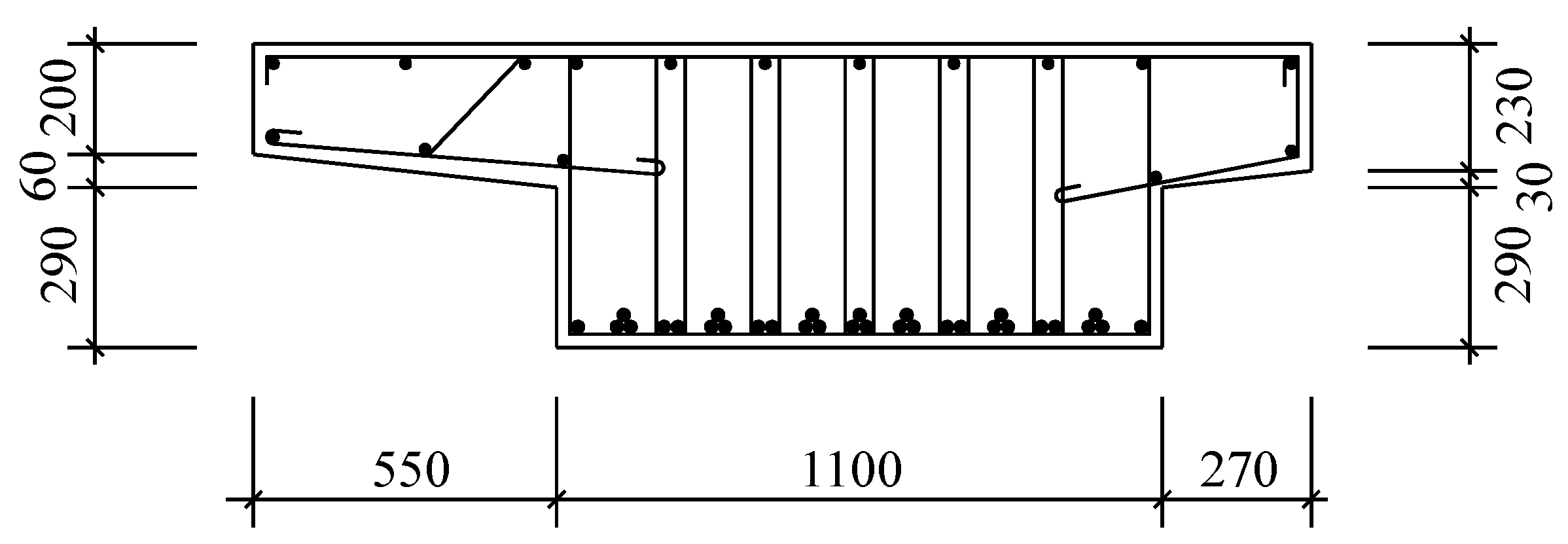
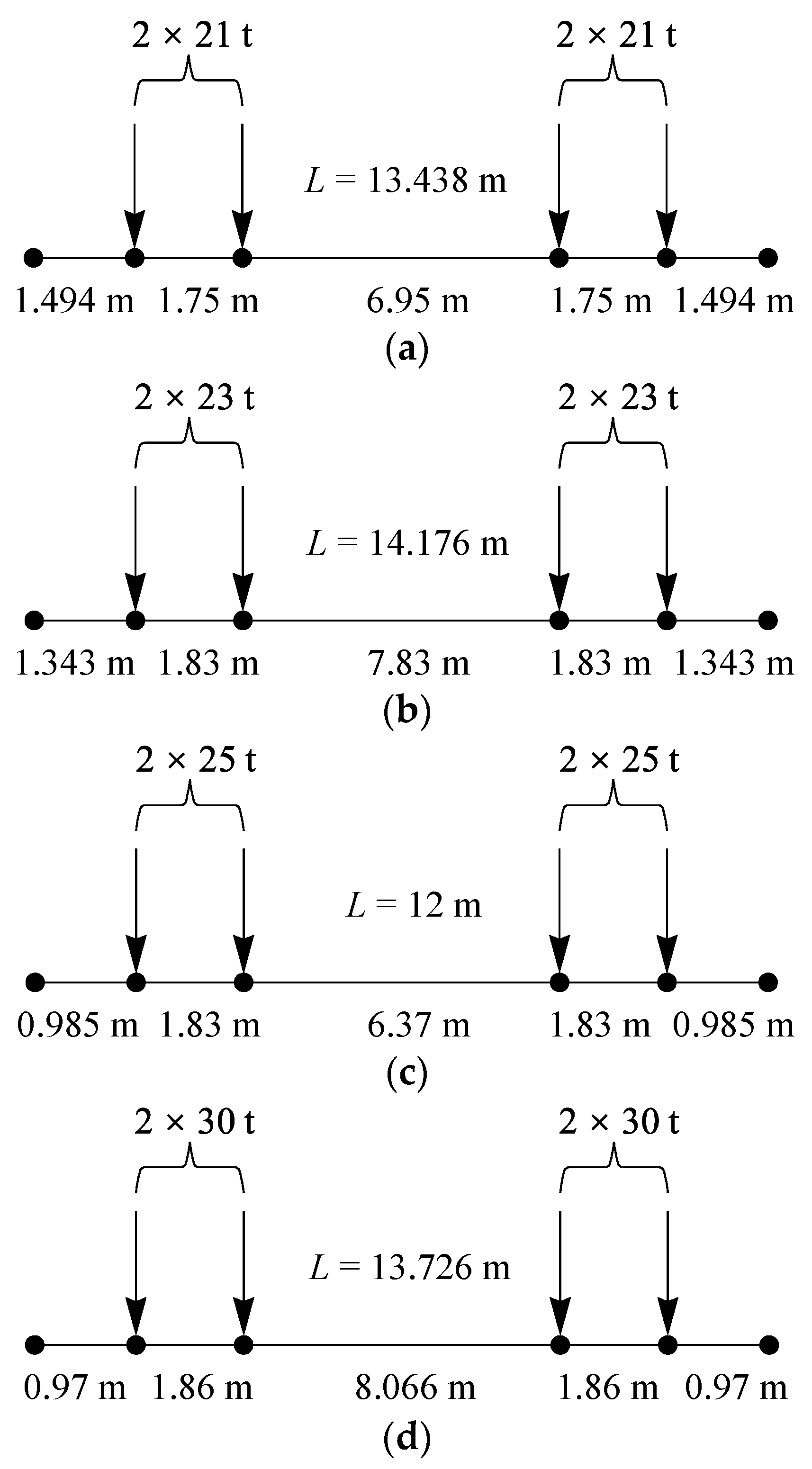
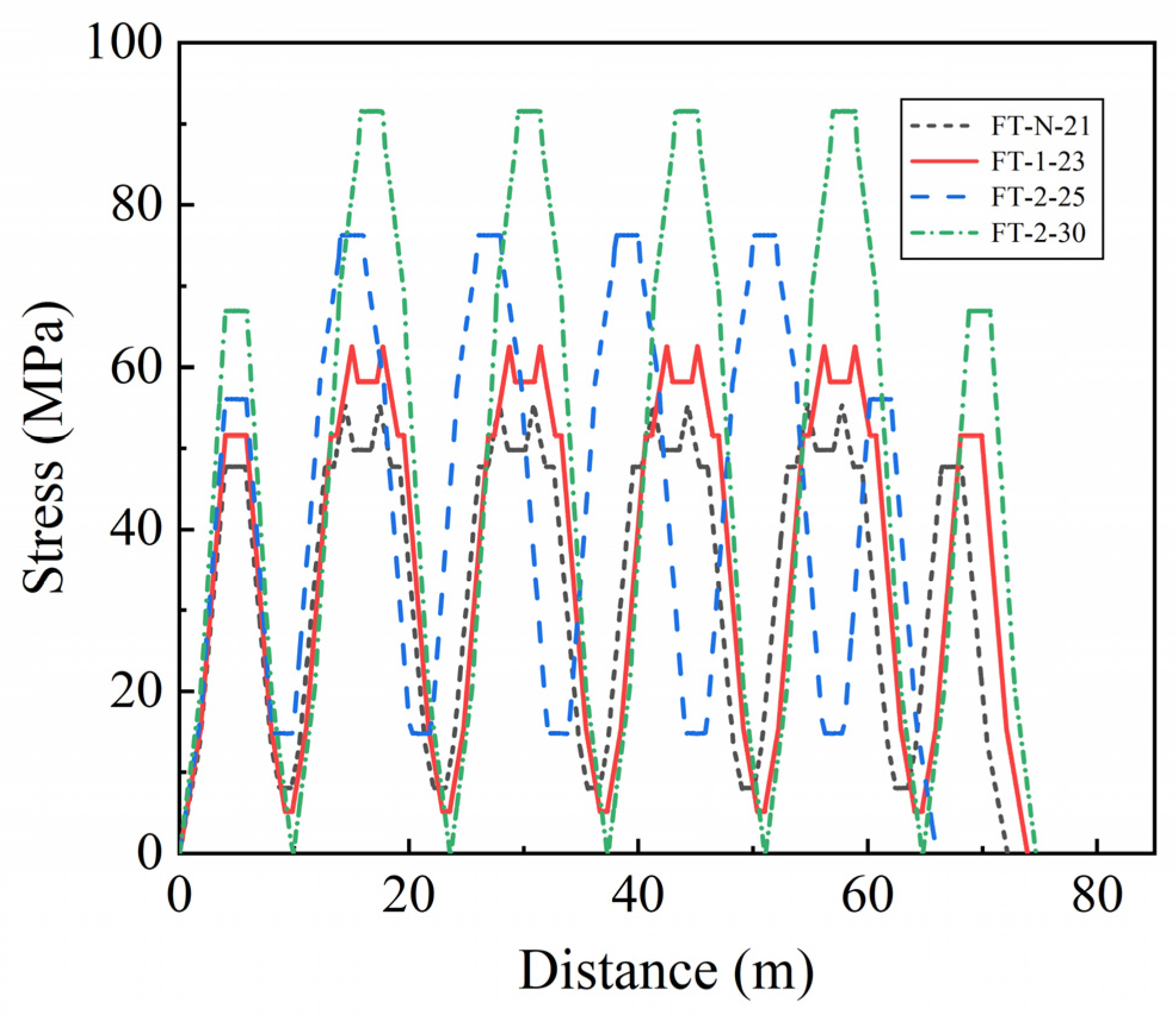
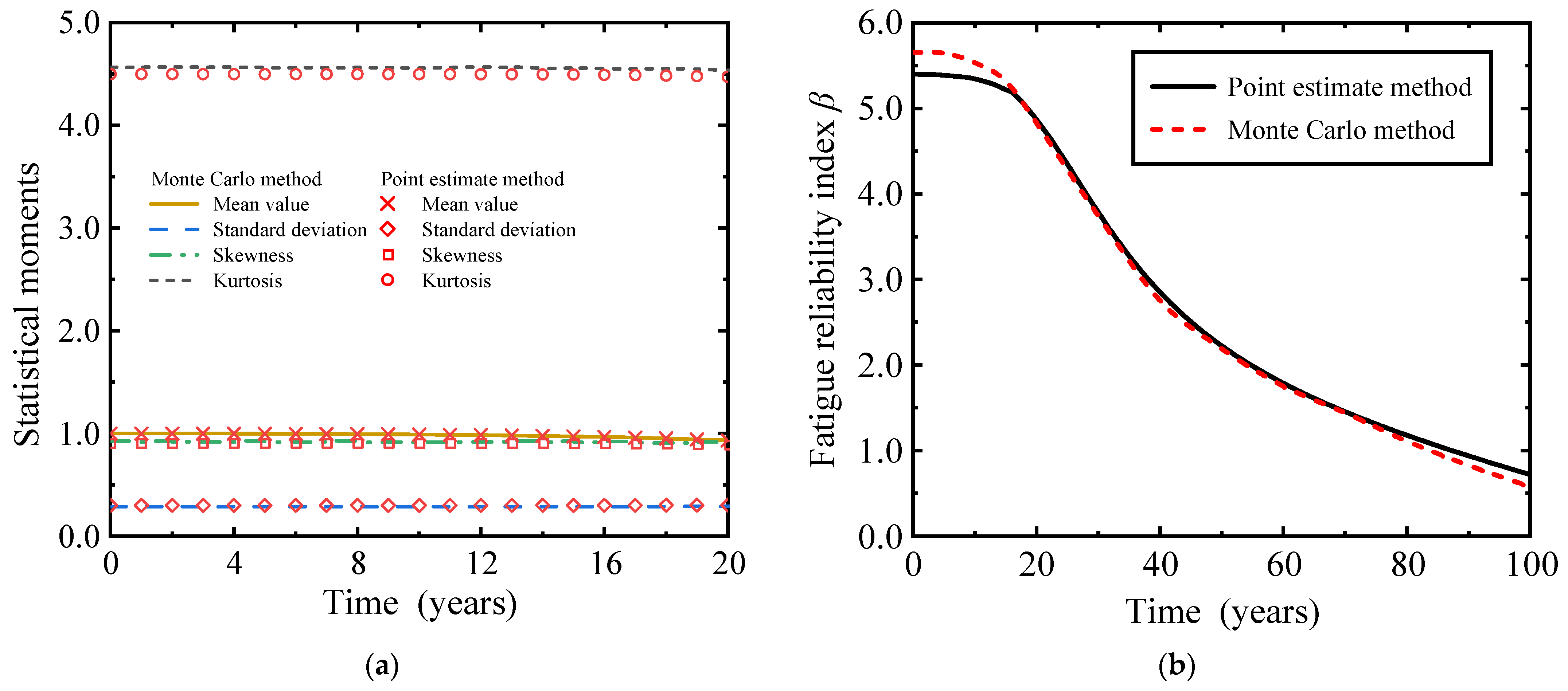
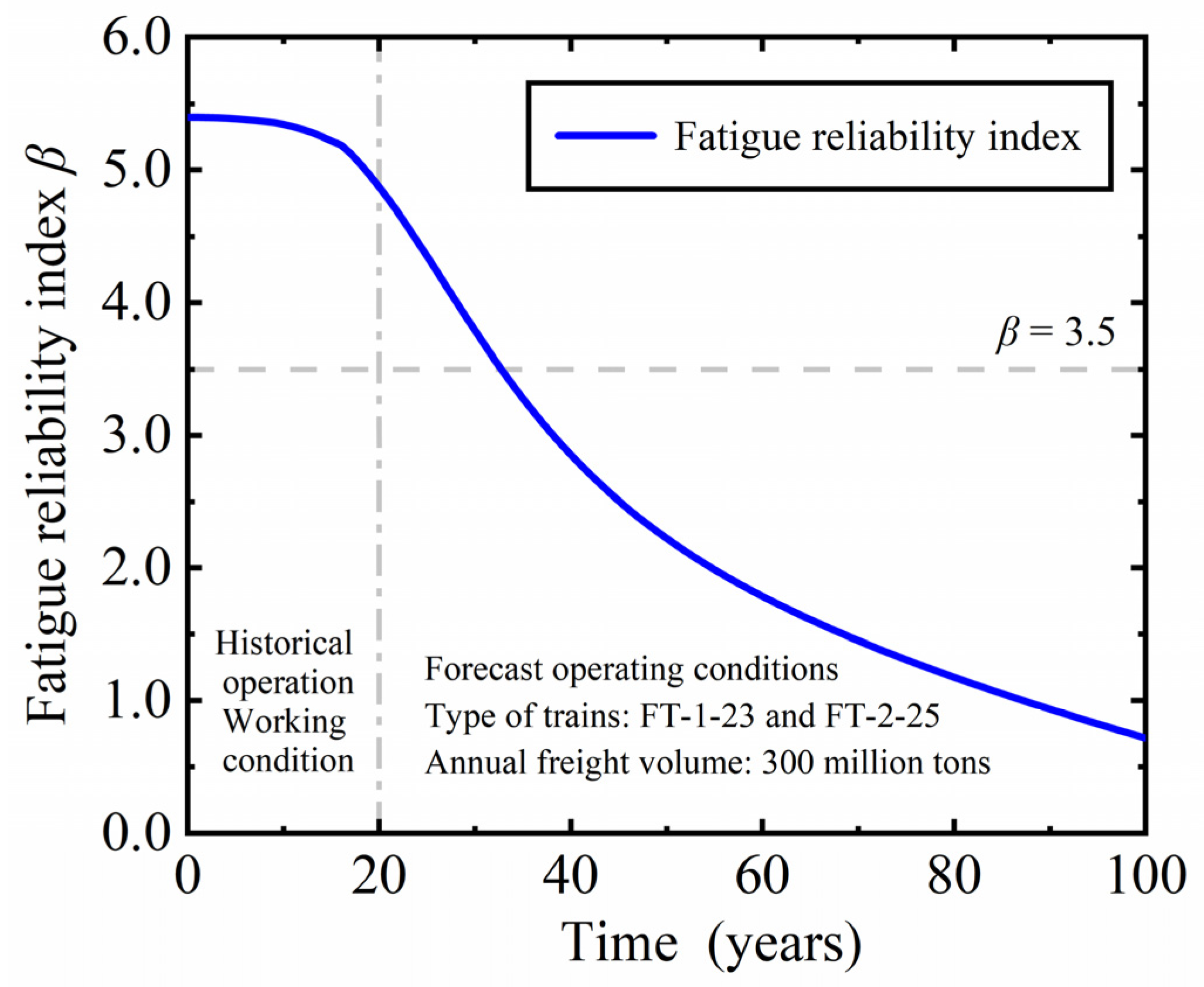
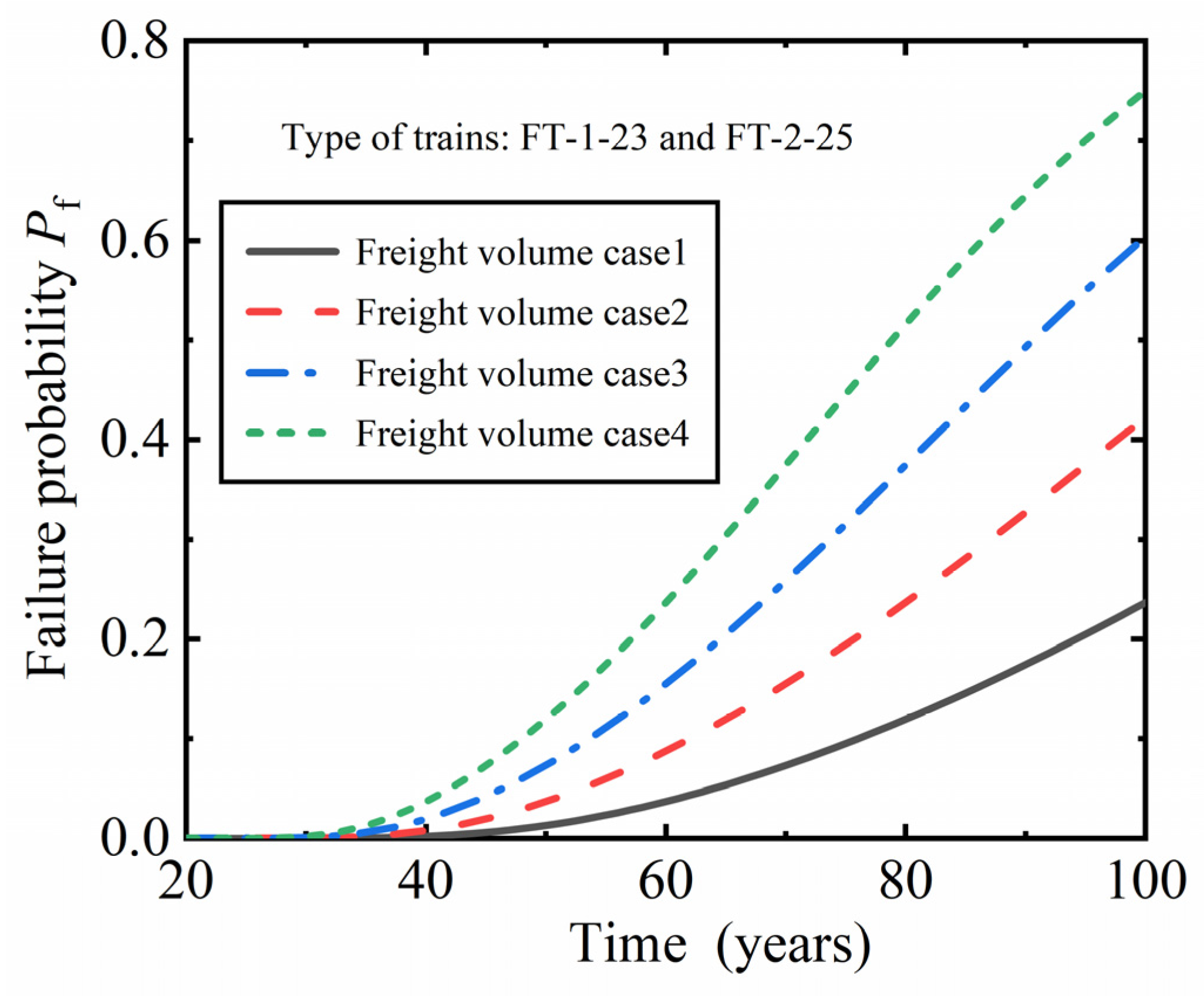
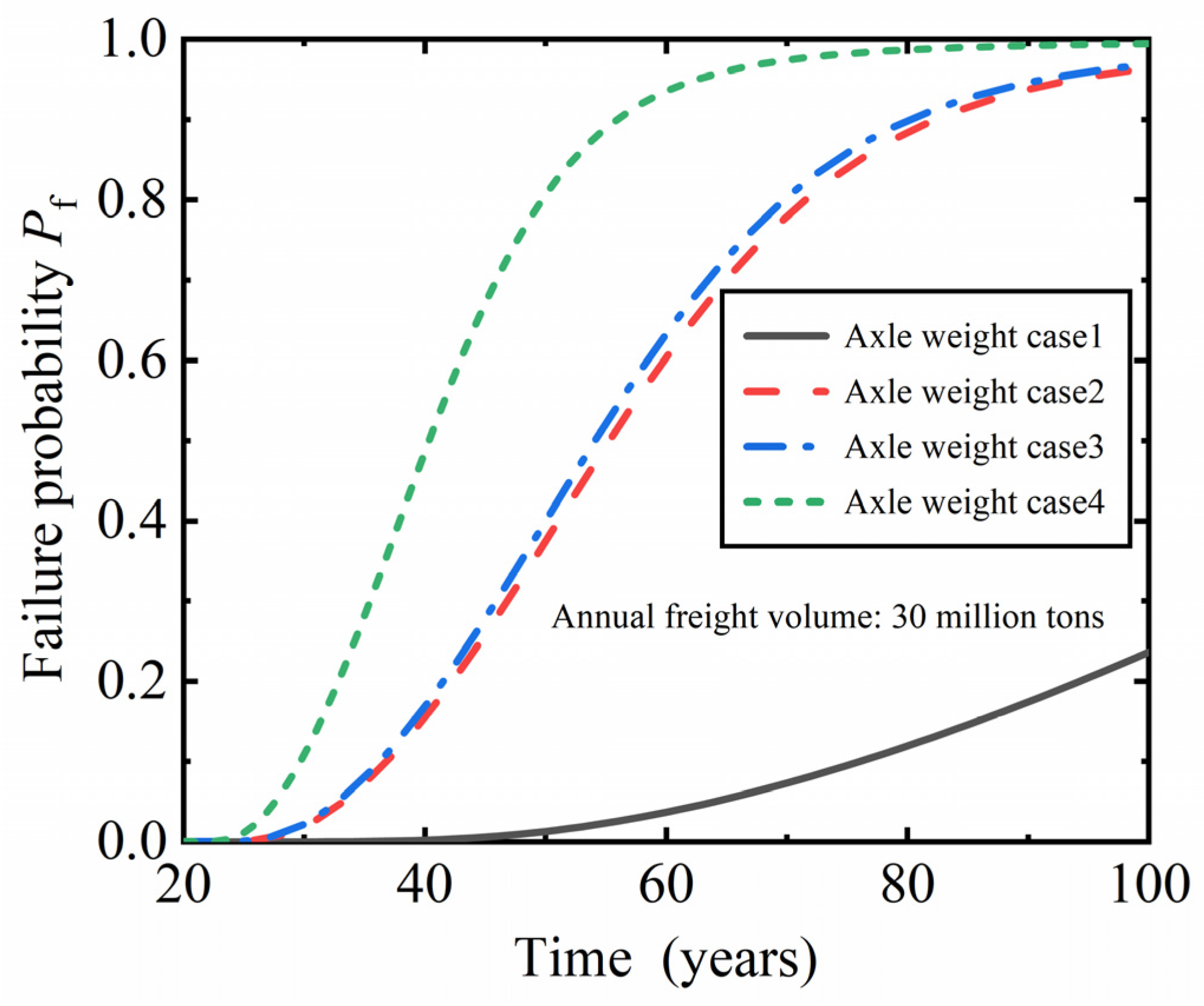
| Integration Point | Weight Values |
|---|---|
| ur,1 = −ur,5 = −2.85697001 | Pr,1 = Pr,5 = 1.12574113 × 10−2 |
| ur,2 = −ur,4 = −1.35562618 | Pr,2 = Pr,4 = 2.22075922 × 10−1 |
| ur,3 = 0 | Pr,3 = 5.33333333 × 10−1 |
| Time (Year) | Annual Volume of Traffic (10,000 Tons) | Train Frequency | ||
|---|---|---|---|---|
| FT-N-21 | FT-1-23 | FT-2-25 | ||
| 1 | 548 | 1361 | - | - |
| 2 | 1655 | 4111 | - | - |
| 3 | 3254 | 8083 | - | - |
| 4 | 5439 | 13,510 | - | - |
| 5 | 7470 | 18,555 | - | - |
| 6 | 9292 | 23,080 | - | - |
| 7 | 11,106 | 27,586 | - | - |
| 8 | 10,133 | 25,169 | - | - |
| 9 | 11,437 | 28,408 | - | - |
| 10 | 14,647 | 18,191 | 9687 | - |
| 11 | 15,900 | 19,747 | 10,516 | - |
| 12 | 16,700 | 20,740 | 11,045 | - |
| 13 | 19,760 | 24,540 | 13,069 | - |
| 14 | 23,957 | 29,753 | 15,845 | - |
| 15 | 25,300 | 31,421 | 16,733 | - |
| 16 | 21,500 | 26,701 | 14,219 | - |
| 17 | 27,200 | - | 17,989 | 8500 |
| 18 | 30,471 | - | 20,513 | 9522 |
| 19 | 31,600 | - | 20,899 | 9875 |
| 20 | 30,450 | - | 20,139 | 9516 |
| Equivalent Stress Range | Train Type | Number of Cycles | Mean Value | Standard Deviation | Skewness | Kurtosis |
|---|---|---|---|---|---|---|
| Sre,21 | FT-N-21 | 132 | 38.2666 | 0.2538 | 0.0531 | 3.0417 |
| Sre,23 | FT-1-23 | 216 | 45.7364 | 0.2265 | 0.0160 | 2.9811 |
| Sre,25 | FT-2-25 | 201 | 56.8803 | 0.2244 | −0.0111 | 3.0650 |
| Sre,30 | FT-2-30 | 168 | 82.8756 | 0.3028 | −0.0111 | 3.0058 |
| Random Variable | Point 1 | Point 2 | Point 3 | Point 4 | Point 5 |
|---|---|---|---|---|---|
| Dc | 0.397055 | 0.643907 | 0.957565 | 1.427190 | 2.210805 |
| C | 3.795159 × 1016 | 8.315966 × 1016 | 1.397218 × 1017 | 2.362295 × 1017 | 4.189110 × 1017 |
| Sre,21 | 37.551659 | 37.925055 | 38.264375 | 38.611873 | 39.013418 |
| Sre,23 | 45.096345 | 45.429573 | 45.735793 | 46.044244 | 46.385149 |
| Sre,25 | 56.227534 | 56.576687 | 56.880709 | 57.183228 | 57.527214 |
| Sre,30 | 82.005459 | 82.464761 | 82.876159 | 83.285502 | 83.737728 |
| Operating Condition | Annual Volume of Traffic (10,000 Tons) | Train Frequency | |
|---|---|---|---|
| FT-1-23 | FT-2-25 | ||
| 1 | 30,000 | 19,841 | 9375 |
| 2 | 40,000 | 26,455 | 12,500 |
| 3 | 50,000 | 33,069 | 15,625 |
| 4 | 60,000 | 39,683 | 18,750 |
| Operating Condition | Train Frequency | ||
|---|---|---|---|
| FT-1-23 | FT-2-25 | FT-2-30 | |
| 1 | 19,841 | 9375 | - |
| 2 | 19,841 | - | 9356 |
| 3 | - | 9375 | 9356 |
| 4 | - | - | 18,713 |
Disclaimer/Publisher’s Note: The statements, opinions and data contained in all publications are solely those of the individual author(s) and contributor(s) and not of MDPI and/or the editor(s). MDPI and/or the editor(s) disclaim responsibility for any injury to people or property resulting from any ideas, methods, instructions or products referred to in the content. |
© 2023 by the authors. Licensee MDPI, Basel, Switzerland. This article is an open access article distributed under the terms and conditions of the Creative Commons Attribution (CC BY) license (https://creativecommons.org/licenses/by/4.0/).
Share and Cite
Shi, J.; Song, L.; Cui, C.; Yu, Z. Fatigue Reliability Assessment of RC Beams in Heavy-Haul Railways Based on Point Estimate Method. Materials 2023, 16, 7098. https://doi.org/10.3390/ma16227098
Shi J, Song L, Cui C, Yu Z. Fatigue Reliability Assessment of RC Beams in Heavy-Haul Railways Based on Point Estimate Method. Materials. 2023; 16(22):7098. https://doi.org/10.3390/ma16227098
Chicago/Turabian StyleShi, Jiarui, Li Song, Chenxing Cui, and Zhiwu Yu. 2023. "Fatigue Reliability Assessment of RC Beams in Heavy-Haul Railways Based on Point Estimate Method" Materials 16, no. 22: 7098. https://doi.org/10.3390/ma16227098
APA StyleShi, J., Song, L., Cui, C., & Yu, Z. (2023). Fatigue Reliability Assessment of RC Beams in Heavy-Haul Railways Based on Point Estimate Method. Materials, 16(22), 7098. https://doi.org/10.3390/ma16227098







